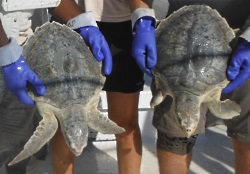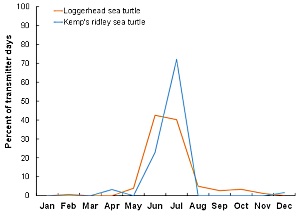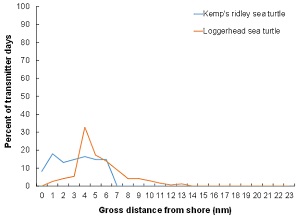Results - Sea Turtles

All but one loggerhead and one Kemp's ridley sea turtle detected in coastal waters off SC and GA were tagged by SCDNR researchers. Fifty-four loggerhead sea turtles were tagged after capture within 10 nm of acoustic receiver arrays between 2014 and 2016, of which 74% were subsequently detected. In contrast, only 16 Kemp's ridley sea turtles have been acoustically tagged after capture within 10 nm of acoustic receivers (all in 2016), of which only six (38%) were later detected.

Loggerhead and Kemp's ridley sea turtles tagged by SCDNR researchers were captured from late May through July, which contributed to increased detection frequency during summer. Only 20% of loggerhead sea turtles acoustically tagged off SC and GA were detected more than 50 days later, but with a maximum detection of 239 days after release. Kemp's ridley sea turtles tagged off GA in summer 2016 were only detected up to 18 days after release during a 65 day observation period. In contrast, a Kemp's ridley tagged after stranding in New York was detected 112 days apart in SC (December 2013) and GA (April 2014) coastal waters.

In contrast to sturgeon, sharks, and rays for which detection frequency peaked five to six miles from shore, sea turtle species were most frequently detected several miles closer to shore. Peak detection frequency for loggerhead sea turtles four miles from shore reflects the SC-centric (79%) nature of data collection and affinity for Charleston shipping channel, where 69% of SC loggerhead sea turtle detection days occurred. Ninety percent of detection days for Kemp's ridley sea turtles in GA stemmed from receivers located in the St. Simon's Sound shipping channel, in contrast to just 21% of loggerhead detection days in GA coastal waters being associated with this shipping channel. Approximately a third of non-channel loggerhead detection days in GA were associated with receivers situated with in detection range of artificial reefs; however, only 6% of non-channel loggerhead detection days in SC stemmed from receivers located within range of such structure.
- View a detection animation for sea turtles
- Species information for loggerhead sea turtles
- Species information for Kemp's ridley sea turtles
